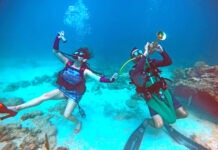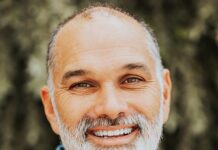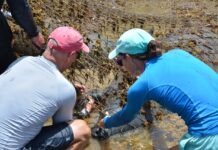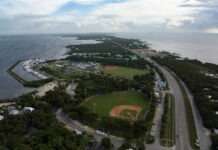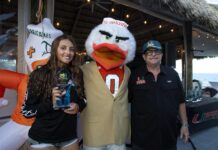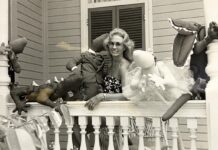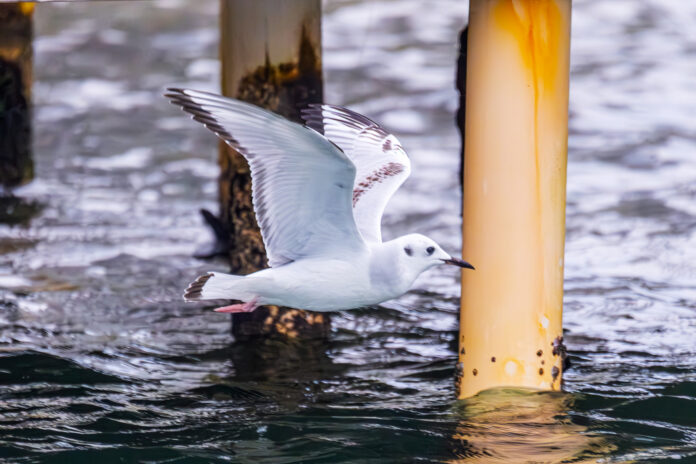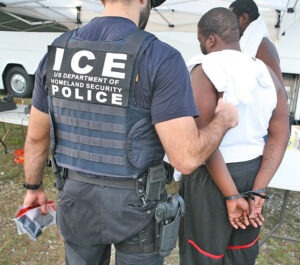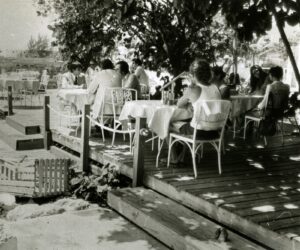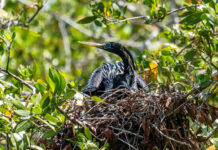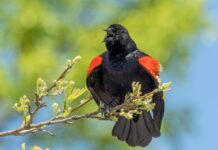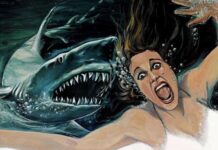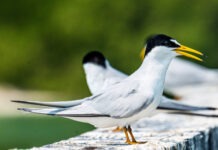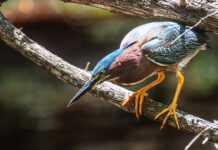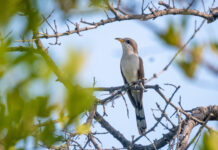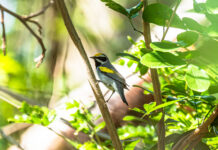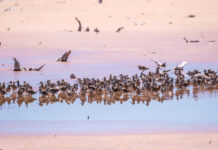My friends Matt and Tara were in town, and we’d been out on the boat most of the afternoon. I’d talked them into a little bit of an expedition partly because I wanted to show them some of the backcountry, and partly because my dog, June, who is not a brave dog, had never been out on the boat, and she really likes Matt and Tara. I thought maybe she’d be a little more adventurous with people she liked.
Sure, June had gone into non-violent resistance mode at the dock and I’d had to carry her onto the boat like a 65-pound sack of potatoes. But once we headed out, she slowly started to get comfortable. On the way back, after we ran through Fleming Key Cut, passed the big hangar on Sigsbee, and began to putter through the no wake zone, she even stood with her front paws up on the bow, like a real boat dog. (I was so proud.)
We didn’t see the gulls until we were halfway back to the entrance of Garrison Bight.
The first word that came to mind when we saw them was “dainty” — not an adjective usually applied to the genus.
Gulls are some of the best fliers out there. They wheel and glide across the sky with the greatest of ease. They can drop in on unsuspecting people and steal their French fries or ice cream cones with a stealthy alacrity rarely seen in the natural world. Arguably they should be considered graceful, but grace to me requires a little showmanship, a little elan, and gulls are generally a little too git-r-dun for that, a little too function-over-form. They make it look so effortless you kind of can’t even appreciate it. Their fondness for garbage doesn’t help, though it does show how adaptable they are.
Except for these gulls.
They were looping around low on the water, landing softly without the hint of a splash, bobbing for a moment, taking off again, then looping around in an unhurried, close-cropped circle before splashing again.
They were mostly white, except for the bill and the large, boldface, large-dot periods behind each eye, looking almost like a second eye on each side of their head.
Gulls are notoriously difficult to identify. This is partly because there are so many similar-looking species, with some even hybridizing, straining the notion of biological species. Also, they take three to four years to reach adulthood, leading to many different plumage patterns.
These two particular gulls were easy, though. There are three species of small gulls in North America which, in winter plumage, have black spot-like shapes on the sides of their head, but only on Bonaparte’s gulls are they so clearly defined. The species is also the only one of the three that gets spotted in Key West every couple of winters.
When we saw them I throttled the boat to a drift, grabbed my camera from the dry bag and started to take pictures.
Bonaparte’s gulls are, at least for the time being, named after Charles Lucien Bonaparte, the nephew of Napoleon Bonaparte, who had to live in exile from France after the emperor’s defeat at Waterloo, something that would later inspire at least one great ABBA song. Charles only lived in the United States for about nine years and wasn’t much of a field guy, but was a whiz at avian nomenclature and classification.
The species is one of the gull species we know the least about, largely because they breed in the remote boggy spaces of Canada and Alaska that are not easily accessible to humans. They are the third smallest gull species in the world and the only gull species that almost always nests in trees, either as single pairs or in very small colonies. They also almost always eschew garbage dumps and parking lots.
I’ve known Tara for close to 30 years now, and Matt since our freshman year of high school, where, as I recall, we had at least one science class together, in which neither of us particularly distinguished ourselves, largely because neither of us was particularly interested. Which is kind of funny, because Matt wrestles largely technical projects for a living and has become a pretty serious home brewer, which requires a lot of chemistry knowledge. And I’ve become a pretty serious birdwatcher, which requires a somewhat solid grasp of a lot of biological concepts. I suppose it comes down to finding the right motivation.
For years Matt has been brewing beers with names like “Boozy Bourbon Ale” and “Discernibly Turbid,” flavoring them with things like spruce sprigs and Jolly Ranchers, entering contests (where he does quite well) and serving them to friends under the moniker of Laughing Gull Brewing. And for nearly as many years I’ve been trying to get him to change the moniker because, well, laughing gulls are kind of a**holes. (I’d describe them as louche, but their disreputability far outpaces their rakish appeal.)
I was trying to make the case again that laughing gulls were an unworthy namesake for his damn fine beers while I was taking pictures and generally marveling at the Bonaparte’s gulls, when both Tara and Matt pointed out that we were drifting across the channel into the path of some slowly oncoming boats. And perhaps I should be paying a little more attention to the whole steering thing. Which kind of threw a big cold bucket on my argument. At least for the moment.
We headed back to the dock after that.
I got a text the next day from my friend Ellen Westbrook, telling me she’d seen two Bonaparte’s gulls flying around the moat at Fort Zach, and I figured it was the same birds we saw. Except when I took the boat out again that afternoon, the two Bonaparte’s gulls that I saw were bobbing in the water of Garrison Bight.
So if you’re inclined to go looking, there’s a chance that the Bonapartes are still around.
If you do see them, and if you happen to run into my friend Matt afterward, maybe extol their superiority to the stupid laughing gull.


